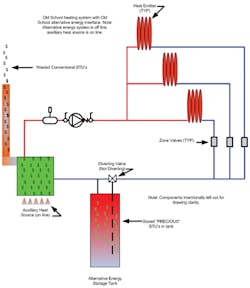In last month's column, we began to address some of the common basic piping violations on primary/secondary interfaces between alternative energy systems and conventional energy systems. This month we continue our journey by discussing the possibility of thermal-siphon heat transfer from the alternative energy heat storage system into the distribution piping system.
In situations where the distribution connections are above the top of the alternative energy storage tank, there is a good chance of thermal-siphon energy transfer occurring, again causing unwanted movement of heat between the heat storage system and the distribution system. Even if the piping interface meets all of the requirements as it pertains to straight pipe considerations before and after the closely spaced tees, and if no preventive actions are taken to avoid thermal siphoning, the hotter, lighter, less dense water will flow out of the storage tank and into the distribution system permitted by thermal siphoning, creating a waste of precious energy.
Historically, it was thought that if a person used anti-thermal siphon traps, it would stop the possibility of thermal siphon occurring. My personal opinion, based on experience, is that what should work in theory does not always perform as it should in the field. There are just too many unpredictable outside forces and influences working against the theoretical in the field. In a “perfect world” you might have a good chance of creating a situation that would not have these issues, but in the “real world” we rarely get the ideal working conditions necessary, hence some suggestions to avoid the situations. (See figure 1 for anti-thermal siphon loop configuration and required straight pipe considerations on primary/secondary systems.)
Whenever possible make certain that the distribution main is at the lowest possible height to avoid setting up a recipe for guaranteed thermal-siphon conditions during the reconstruction, re-piping process. If that is not possible, I would recommend the use of a spring check on the down flowing pipe between the main and the heat storage tank, and either a gravity check or a spring check on the pipe between the heat storage tank and its connection to the main distribution pipe.
Although the check valves do represent a resistance value to the flowing fluid, the additional parasitic power consumption necessary to overcome this resistance is insignificant when compared to the uncontrolled loss of precious solar and other alternative energy Btus.
I have also seen situations whereby the designer/installer would place a zone valve on the supply piping between the storage tank and the distribution main, and nothing on the return pipe.
Under these conditions, it is entirely possible, and in fact probable, that you will experience phenomena known as one pipe thermal siphon. This is where the hot water flows upward through the center core of the pipe while the cooler water in constant contact with the outer surface flows downward. All of this is occurring within a single pipe, hence the term, one pipe thermal siphon. The best method of guarding against this potential is to “plug” the energy leaks in both pipes as previously outlined with the use of check valves, or avoid the problem all together by thinking ahead and running the distribution main near the lowest point possible.
Tune in next month as we continue to learn the optimum piping methodology for interfacing alternative energy into conventional hydronic heating systems.
Until then, happy St. Valentine's Day hydronicing!
Mark Eatherton is a Denver-based hydronics contractor. He can be reached via e-mail at [email protected] or by phone at 303/778-7772.
About the Author
Mark Eatherton
Mark Eatherton material on this website is protected by Copyright 2017. Any reuse of this material (print or electronic) must first have the expressed written permission of Mark Eatherton and CONTRACTOR Magazine.
